Structure and Kinematics of the Circumstellar Gas on Few Hundred AU Scales near the L483 Protostar

First, L483 is shown with images from the
National Radio Astronomy Observatory 12m radiotelescope, and optically.
(NRAO).
Optical and radio views of The L483 Molecular Cloud.
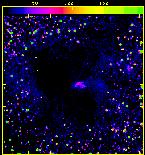 In the infrared image (in the `J' band at 1.2 microns)
in the this panel, the dark cloud L483 stands out
against a Scutum starfield. Deep within, a purple glow locates one lobe of
a flow emanating from the densest part of the cloud, completely hidden from
view at even the longest infrared wavelengths accessible from the Earth's
surface. At these wavelengths, we could never peer into the cloud and
uncover the mechanisms of star formation. Radio techniques remedy this
situation. Image courtesy of Gary Fuller.
In the infrared image (in the `J' band at 1.2 microns)
in the this panel, the dark cloud L483 stands out
against a Scutum starfield. Deep within, a purple glow locates one lobe of
a flow emanating from the densest part of the cloud, completely hidden from
view at even the longest infrared wavelengths accessible from the Earth's
surface. At these wavelengths, we could never peer into the cloud and
uncover the mechanisms of star formation. Radio techniques remedy this
situation. Image courtesy of Gary Fuller.
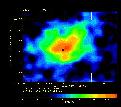 The bottom panel shows an image of C18O J=1-->0 emission
taken by the NRAO 12m radiotelescope. Here the interstellar gas glows
with emission from the carbon monoxide molecules, which, mixed with dust,
completely obscured the star-forming interior of the cloud in the previous
image. Note how the gas glows
most brightly where accretion onto a protostar warms the cloud. Only a dozen
or so objects in the sky are thought to be as young as this protostar, which
appears to be growing into a young star of about the same mass as the Sun.
At this stage in its evolution, however, most of the matter which will
eventually be incorporated into the star and its planets still lies in the
surrounding cloud. Thus the L483 protostar offers us a chance to understand
how interstellar gas and dust clouds form stars and planets.
The bottom panel shows an image of C18O J=1-->0 emission
taken by the NRAO 12m radiotelescope. Here the interstellar gas glows
with emission from the carbon monoxide molecules, which, mixed with dust,
completely obscured the star-forming interior of the cloud in the previous
image. Note how the gas glows
most brightly where accretion onto a protostar warms the cloud. Only a dozen
or so objects in the sky are thought to be as young as this protostar, which
appears to be growing into a young star of about the same mass as the Sun.
At this stage in its evolution, however, most of the matter which will
eventually be incorporated into the star and its planets still lies in the
surrounding cloud. Thus the L483 protostar offers us a chance to understand
how interstellar gas and dust clouds form stars and planets.

Next, L483 is shown with images from the
National Radio Astronomy Observatory Very Large Array radiotelescope,
and from the James Clerk Maxwell Telescope,
a 15m telescope located atop Mauna Kea on Hawaii, using the
SCUBA
submillimeter detector array.
Structure and Kinematics of the Circumstellar Gas on Few Hundred AU Scales near the L483 Protostar
Alwyn Wootten
NRAO
Gary Fuller
NRAO, UMIST
Abstract submitted to the 198th meeting of the AAS:
The far-infrared source in L483 numbers among the youngest protostars. We
report high angular resolution images of the submillimeter emission obtained
with SCUBA on the JCMT, and high spatial and spectral resolution images of
the NH(1,1) and (2,2) lines obtained with the VLA. These images suggest
that the disk currently accretes matter from the surrounding cloud.
The highest optical depth line is the main hyperfine component of the (1,1)
line, which is much weaker than the satellite line near the FIR source.
The velocity of this component shifts significantly blueward within
2000 AU of the FIR source. Such a shift signifies that material between
the observer and the optically thick envelope of the protostellar core
is moving away from the observer, or falling toward the protostar.
The infall solution found by Shu (1977) was used to model the region
interior to an expansion wave which propagates outward from the center of
a singular isothermal sphere. Ammonia spectra were then synthesized and
matched to the observations through adjustments to the model. The modeled
profiles show enhanced linewidth in the (2,2) line relative to the (1,1)
line, as well as a shift of emergent spectra towards lower line center
velocity, though not so large as observed. We conclude that the ammonia
images demonstrate that infall occurs within the central 5000 AU of the
core centered on L483-FIR, but that more elaborate models will be necessary
to fit the kinematics of the region in detail.
Al Wootten
Wed Oct 22 15:40:19 EDT 1997
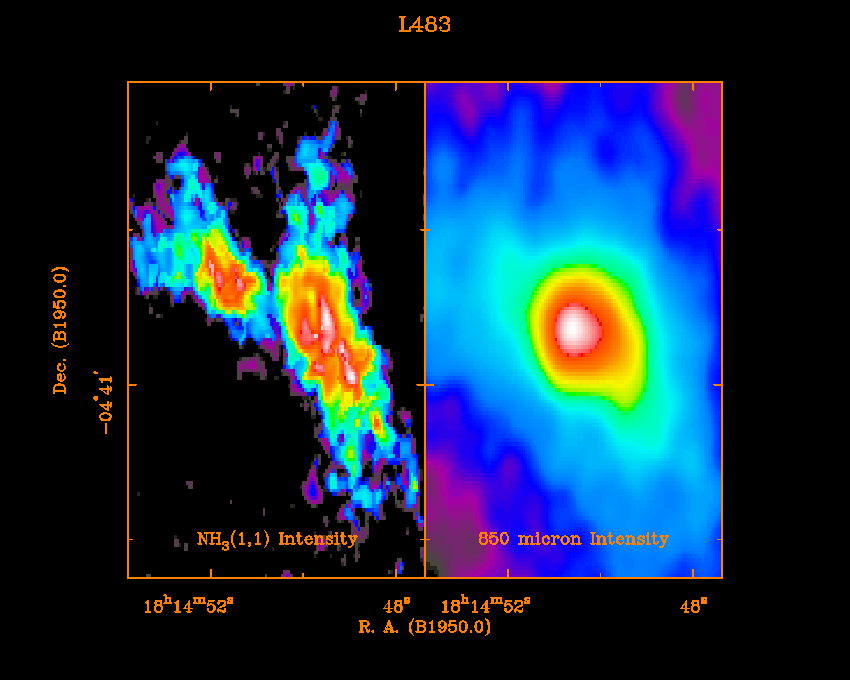
On the left is the VLA image, taken with 4" resolution, of emission in the
(J,K)=(1,1) line of ammonia (NH3). This image shows the location
of cool gas molecules--velocity information has been averaged to give an
overall view of the source. On the right is the JCMT
image, at a wavelength of 850 microns, taken with the SCUBA instrument.
The image on the right is emission from dust grains, with a spatial
resolution of 15". The images differ somewhat, with the dust image dominated
by a bright source. This source coincides with the position of emission from
hot water molecules and free electrons, as seen in other VLA images. The
bright source locates the protostar.
Why do the two images look dissimilar around the protostar? For one thing,
the star undoubtedly heats its environment. When dust is heated, it
glows more brightly. When ammonia is heated, the molecule emits more
strongly at other frequencies. Therefore, in this low energy emission line,
we are selecting out cool gas to image, with hot gas suppressed.
For comparison, examine the image below, which shows the source in the
light of an emission line which requires more energy to excite.
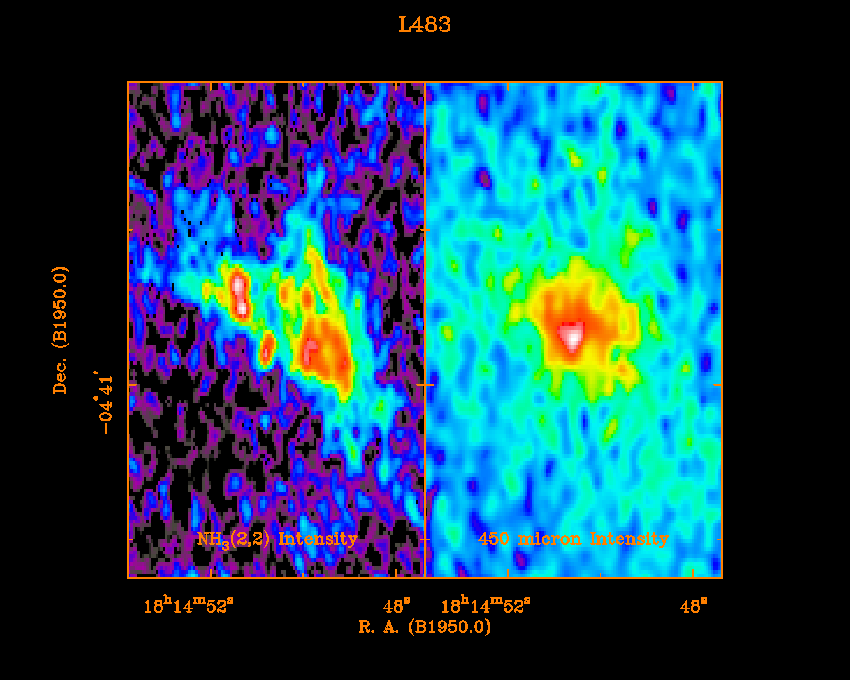
On the left is the VLA image of emission in the (J,K)=(2,2) line of
ammonia, a line which lies about 60K above zero energy, and about 40 K
above the (1,1) line pictured above. On the right is the JCMT image
at 450 microns, again taken with SCUBA at a resolution of 9".
The bright protostar is now visible in both images, as we are selectively
imaging warmer gas now, gas associated with the protostar.

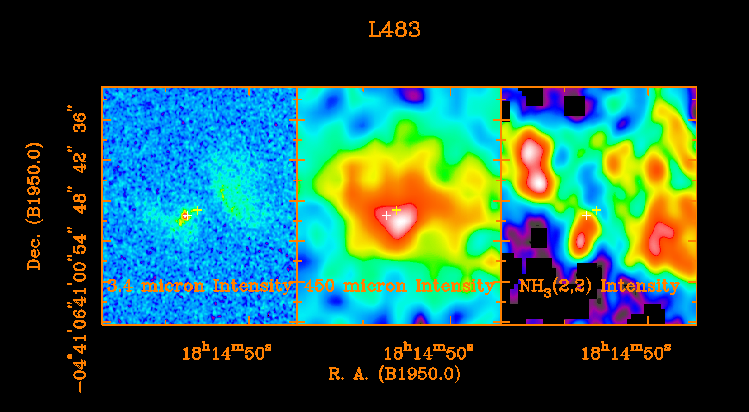
Finally, L483 is shown with images from the
National Radio Astronomy Observatory Very Large Array radiotelescope,
and from the IRTF,
a 4m telescope located atop Mauna Kea on Hawaii, using the
NSFCAM
infrared CCD array at 3.4 micron wavelength.
On the right is the VLA image of emission in the (J,K)=(2,2) line of
ammonia, and in the center the 450 micron image from SCUBA, shown more
extensively above, and on the left is the infrared
image at 3.4 microns. Note that the star is buried
deep within the obscuring lane passing from northeast to southwest. On
each side of the lane, some indication of indirect illumination by the
central star, invisible in this image, can be seen. Interestingly, portions
of the absorbing lane show up brightly in emission at 450 microns, but
appear suppressed in the ammonia line. The yellow cross designates the
position of a 6cm radio continuum source while the white cross locates
the position of a water maser at VLSR=5.8 km/s.
Figures generated using WIP
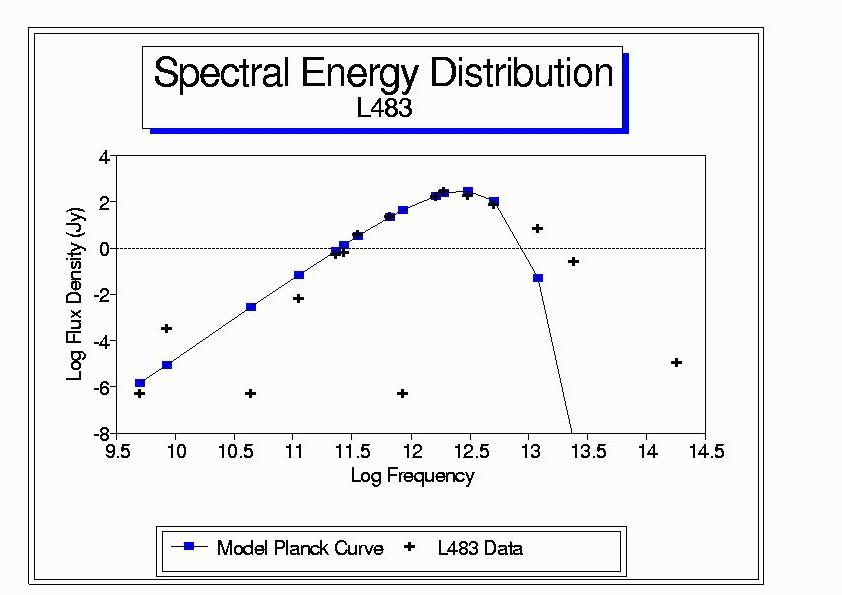
Above is shown the spectral energy distribution of L483. It is characterized
by a luminosity just below 20 solar luminosities and a bolometric temperature of
50K. The blackbody curve shown is calculated for a dust temperature of 30 K.
About 0.4 solar masses of cool circumstellar dust apparently accompany the
star.
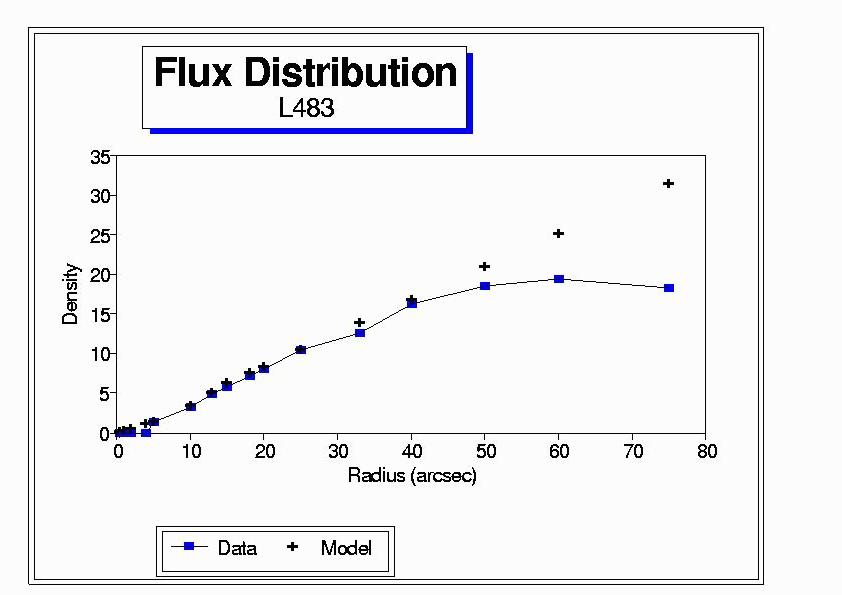
The distribution of flux density (Jy) lies along the y-axis, as observed with
SCUBA. Compared to that are flux densities computed from the densities in
our infall model. Considering that the infall model was derived from
ammonia observations alone, and not substantially constrained by the
SCUBA observations, we consider the fit to be excellent.

Back to my
Home Page











